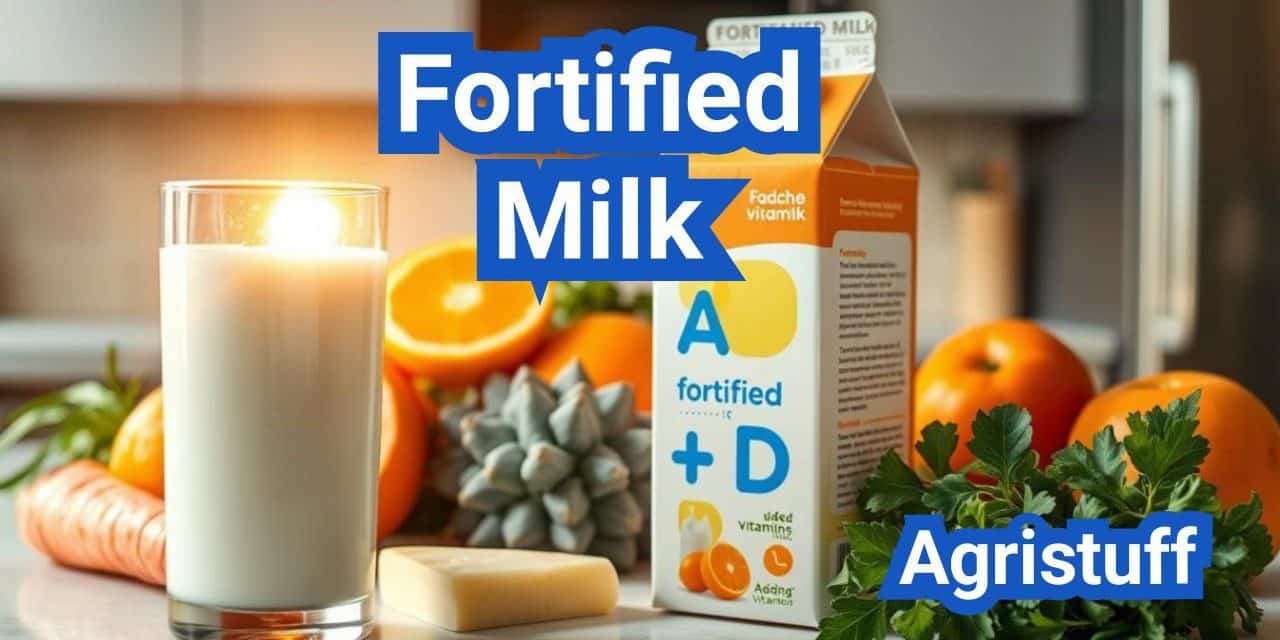This article does not contain medical advice
Fortified dairy products have become a staple in modern nutrition, offering enhanced nutritional benefits beyond those naturally present in regular dairy. Vitamin A and D are commonly added to milk, providing essential nutrients that support overall health.
The importance of fortified milk lies in its ability to address nutritional deficiencies, particularly in populations with limited access to a balanced diet. By understanding the labeling and benefits of fortified milk, consumers can make informed choices about their dairy intake.
Key Takeaways
- Fortified milk provides additional nutritional benefits beyond regular milk.
- Vitamin A and D are essential nutrients added to fortified milk.
- Labeling of fortified milk helps consumers make informed choices.
- Fortified milk is particularly beneficial for populations with limited access to a balanced diet.
- Consumers can benefit from understanding the benefits and labeling of fortified milk.
What Is Fortified Milk? Understanding the Basics
Fortified milk is more than just regular milk; it’s enriched with essential vitamins and minerals. This enhancement is achieved through a process known as fortification, which involves adding micronutrients to milk to address nutritional deficiencies.
Definition and Meaning of Fortification
Fortification refers to the practice of adding nutrients to food products to enhance their nutritional value. In the context of milk, fortification typically involves adding vitamins A and D, among other nutrients. This process is crucial in combating deficiencies and promoting overall health.
History of Milk Fortification in the United States
The practice of fortifying milk with vitamins began in the 1930s in the United States, primarily to combat rickets and other bone diseases. This initiative was a response to widespread vitamin D deficiency, which was prevalent at the time. By adding vitamin D to milk, the incidence of rickets significantly decreased, showcasing the effectiveness of milk fortification.
Common Nutrients Added to Fortified Milk
Fortified milk typically contains added vitamins A and D. Vitamin D is crucial for calcium absorption and bone health, while vitamin A is important for vision, immune function, and skin health. The addition of these vitamins enhances the nutritional profile of milk, making it a more wholesome beverage option.
Understanding the basics of fortified milk is essential for making informed dietary choices. By recognizing the benefits and the process behind milk fortification, consumers can better appreciate the value of this enhanced nutritional product.
The Science Behind Milk Fortification
Understanding the science behind milk fortification reveals the intricacies involved in enriching milk with essential vitamins and minerals. The process begins with a thorough analysis of the nutritional content of the milk, followed by the addition of specific vitamins and minerals to enhance its value.
How Vitamins Are Added to Milk
The addition of vitamins to milk is a precise process. Manufacturers use a fortification process that involves adding measured amounts of vitamins A and D, among others, to the milk during processing. This is typically done by injecting a vitamin premix into the milk stream or by adding it to the milk storage tank. The goal is to ensure uniform distribution of the added nutrients.
Vitamin A palmitate and Vitamin D3 are commonly used in milk fortification due to their stability and bioavailability. The exact amount added is determined based on dietary recommendations and the desired nutritional profile of the final product.
Stability of Added Nutrients
The stability of the added nutrients is crucial for the effectiveness of the fortification process. Vitamins A and D are generally stable in milk, but their potency can be affected by factors such as light exposure, storage conditions, and packaging. To mitigate these effects, manufacturers often use opaque packaging and store the milk under controlled conditions to preserve the nutritional content.
Quality Control in the Fortification Process
Quality control is a critical aspect of milk fortification. Manufacturers implement rigorous testing protocols to ensure that the milk meets the required nutritional standards. This includes regular checks on the levels of added vitamins and minerals, as well as monitoring the overall quality of the milk. By maintaining high standards of quality control, manufacturers can guarantee the safety and nutritional value of the fortified milk.
Fortified Milk in the United States: Regulations and Standards
In the United States, the fortification of milk is governed by a set of rules and standards enforced by the FDA. These regulations ensure that fortified milk products meet specific nutritional standards, providing consumers with safe and healthy options.
FDA Requirements for Milk Fortification
The FDA sets strict guidelines for the fortification of milk, including the levels of vitamins A and D that must be added. Vitamin A is crucial for vision, immune function, and skin health, while Vitamin D is essential for calcium absorption and bone health. The FDA requires that these vitamins be added to milk in specific amounts to ensure consistency across products.
The FDA’s regulations also cover the quality control measures that manufacturers must implement during the fortification process. This includes regular testing to ensure that the milk contains the correct levels of added nutrients.
Mandatory vs. Optional Fortification
While the addition of vitamins A and D to milk is mandatory in many states, other nutrients may be added optionally. For example, some manufacturers may choose to fortify their milk with additional calcium or vitamin E. The FDA regulates these optional fortifications to ensure they are safe and accurately labeled.
State-Specific Regulations
Some states have their own regulations regarding milk fortification, which may be more stringent than federal standards. For instance, certain states may require additional nutrients to be added to milk or have specific labeling requirements. Manufacturers must comply with both federal and state regulations when producing and distributing fortified milk products.
| State | Additional Fortification Requirements | Labeling Requirements |
|---|---|---|
| California | Additional calcium | Specific vitamin content labeling |
| New York | Vitamin E | Detailed nutrition facts panel |
| Texas | None | Standard labeling requirements |
Understanding these regulations is crucial for both manufacturers and consumers. By adhering to FDA and state-specific guidelines, manufacturers can ensure that their fortified milk products are safe, nutritious, and compliant with the law.
How to Identify Fortified Milk Products on Store Shelves
When shopping for milk, understanding how to identify fortified options is crucial for making informed nutritional choices. Fortified milk products offer enhanced nutritional benefits, but distinguishing them from regular milk requires a closer look at the packaging.
Reading Milk Labels Correctly
The first step in identifying fortified milk is to read the labels correctly. Milk labels contain a wealth of information, including the type of milk, added nutrients, and nutritional content. To identify fortified milk, look for keywords such as “fortified with vitamin D” or “enriched with calcium.”
Key Label Terms to Watch For:
- Vitamin A & D fortified
- Calcium enriched
- Additional nutrients like iron or protein
Understanding Nutrition Facts Panels
The Nutrition Facts Panel provides detailed information about the milk’s nutritional content. When comparing different milk products, this panel can help you identify which ones are fortified with additional vitamins and minerals.
Important Information to Check:
- Vitamin D and calcium content
- Presence of other fortified nutrients
- % Daily Value (DV) to understand the nutritional contribution
Daily Values and Percent DV Explained
Understanding Daily Values (DV) and Percent DV is crucial for assessing the nutritional value of fortified milk. The %DV indicates how much of a particular nutrient the milk provides relative to the daily recommended intake.
| Nutrient | %DV | Significance |
|---|---|---|
| Calcium | 30% | Supports bone health |
| Vitamin D | 25% | Aids in calcium absorption |
Importance of Opaque Packaging
Opaque packaging is often used for fortified milk to protect the vitamins, especially vitamin D, from degradation caused by light exposure. Checking the packaging can provide insights into the product’s quality and nutritional preservation.
By following these guidelines, consumers can effectively identify fortified milk products on store shelves, making it easier to make healthier choices.
Popular Fortified Milk Brands in America
American consumers have access to a broad spectrum of fortified milk brands, ranging from national chains to regional and organic options. This diversity allows consumers to choose products that best fit their nutritional needs and preferences.
Major National Brands
Several major national brands dominate the fortified milk market in the United States. These include:
- Dairy Pure: Known for its high-quality milk products, Dairy Pure offers a range of fortified milk options.
- Organic Valley: While primarily an organic brand, Organic Valley also offers fortified milk products that are popular among health-conscious consumers.
- Fairlife: This brand is recognized for its ultra-filtered milk products, some of which are fortified with additional nutrients.
Regional Fortified Milk Options
In addition to national brands, regional options are also available, catering to local tastes and preferences. Some notable regional brands include:
- Darigold: Primarily popular in the Pacific Northwest, Darigold offers fortified milk products that are well-regarded locally.
- Milk-Bone’s regional variants: Some regional variants of Milk-Bone offer fortified milk options tailored to specific market needs.
Organic Fortified Milk Products
For consumers seeking organic options, several brands offer organic fortified milk products. These include:
- Organic Valley: As mentioned, Organic Valley offers a range of organic fortified milk products.
- Stonyfield: Known for its organic yogurt, Stonyfield also offers organic fortified milk options.
Fortified Milk vs. Fresh Milk: What You Need to Know

Fortified milk and fresh milk have distinct characteristics that cater to different dietary needs and preferences. While both types of milk are nutritious, they differ in terms of their nutritional content, taste, shelf life, and price.
Nutritional Comparison
Fortified milk is enriched with additional vitamins and minerals, such as vitamin D and calcium, making it a better choice for those seeking extra nutritional benefits. In contrast, fresh milk is often considered a more natural option, with its nutritional profile dependent on the cow’s diet and breed.
A comparison of the nutritional values of fortified and fresh milk reveals some key differences:
- Fortified milk typically contains higher levels of vitamin D and calcium.
- Fresh milk may have a higher content of certain nutrients like protein and vitamins B12 and B2.
- The fortification process can enhance the nutritional profile of milk, making it more suitable for specific dietary needs.
Taste and Texture Differences
The taste and texture of fortified milk can differ from those of fresh milk due to the fortification process. Some consumers may notice a slightly sweeter or more processed taste in fortified milk.
The texture of fortified milk is often similar to that of fresh milk, but it can be affected by the type of fortification used. For example, milk fortified with calcium may have a slightly thicker consistency.
Shelf Life and Storage Requirements
Fortified milk generally has a longer shelf life than fresh milk due to the pasteurization and fortification processes. However, both types of milk require proper storage to maintain their quality.
Key storage considerations include:
- Refrigerating milk at a consistent temperature below 40°F (4°C).
- Keeping milk away from direct light and heat sources.
- Consuming milk before its expiration date.
Price Considerations
The price of fortified milk is often higher than that of fresh milk due to the additional processing steps involved. However, the cost difference may be justified by the enhanced nutritional benefits of fortified milk.
When choosing between fortified and fresh milk, consumers should consider their individual needs and priorities. Factors such as nutritional requirements, taste preferences, and budget should all be taken into account.
The Benefits of Fortified Milk for Overall Health

With its rich nutritional profile, fortified milk supports various bodily functions, from bone health to immune system function. Fortified milk is enriched with vitamins and minerals that are essential for maintaining overall health. The addition of these nutrients helps bridge the nutritional gaps in the average American diet.
Bone Health and Calcium Absorption
Fortified milk is an excellent source of calcium and vitamin D, both crucial for bone health. Calcium is essential for building and maintaining bone density, while vitamin D facilitates calcium absorption in the body. Together, they help prevent conditions like osteoporosis and rickets.
The role of fortified milk in supporting bone health cannot be overstated. Regular consumption can lead to improved bone density, reducing the risk of fractures and osteoporotic fractures, particularly in older adults.
Immune System Support
Fortified milk contains vitamins A and D, which play significant roles in immune system support. Vitamin A is crucial for the integrity of the epithelial lining, a barrier against infections, while vitamin D has been shown to modulate immune responses and reduce the risk of autoimmune diseases.
Cognitive Function Benefits
Nutrients in fortified milk, such as vitamin B12 and omega-3 fatty acids (in some varieties), contribute to cognitive function. Vitamin B12 is involved in the synthesis of myelin, the fatty substance that surrounds nerve fibers, while omega-3 fatty acids support brain health.
Addressing Nutritional Gaps in the American Diet
The American diet often lacks essential nutrients due to various factors, including busy lifestyles and dietary preferences. Fortified milk helps address these nutritional gaps by providing a convenient and effective way to intake necessary vitamins and minerals.
| Nutrient | Role in the Body | Benefit of Fortified Milk |
|---|---|---|
| Calcium | Essential for bone health | Supports bone density |
| Vitamin D | Facilitates calcium absorption | Enhances bone health |
| Vitamin A | Supports immune function | Boosts immune system |
Understanding Vitamin D in Fortified Milk

Vitamin D plays a crucial role in fortified milk, contributing significantly to bone health and calcium absorption. Fortified milk is enriched with vitamin D to enhance its nutritional value and support overall health.
Forms of Vitamin D Used in Fortification
There are two main forms of vitamin D used in fortification: vitamin D2 (ergocalciferol) and vitamin D3 (cholecalciferol). Vitamin D3 is more effective at raising and maintaining serum 25-hydroxyvitamin D levels, making it a preferred choice for many manufacturers.
Recommended Daily Intake of Vitamin D
The recommended daily intake of vitamin D varies by age and other factors. Generally, the recommended dietary allowance (RDA) is:
- 600 IU (International Units) for children and adults up to 70 years
- 800 IU for adults over 70 years
It’s essential to consult healthcare professionals for personalized recommendations.
Vitamin D Deficiency Risks and Prevention
Vitamin D deficiency can lead to various health issues, including rickets in children, osteomalacia in adults, and increased risk of osteoporosis. Prevention strategies include consuming fortified milk, spending time outdoors, and considering supplements if necessary.
Key groups at risk for vitamin D deficiency include:
- Older adults
- Individuals with limited sun exposure
- People with darker skin tones
By understanding the importance of vitamin D and taking proactive steps, individuals can maintain optimal levels and support their overall health.
Vitamin A Palmitate in Milk: Benefits and Safety

Vitamin A palmitate, a form of vitamin A, is commonly used in milk fortification due to its stability and effectiveness. This nutrient plays a crucial role in various bodily functions, including vision, immune function, and skin health.
What Is Retinyl Palmitate?
Retinyl palmitate is another term for vitamin A palmitate, which is a compound used in the fortification of milk. It is a stable form of vitamin A that can be easily absorbed by the body. The use of retinyl palmitate in milk ensures that consumers receive the nutritional benefits of vitamin A in a form that is both effective and safe.
Safety Concerns and Research Findings
While vitamin A palmitate is generally considered safe, there have been some concerns regarding its potential impact on health when consumed in high amounts. Research has indicated that excessive intake of vitamin A can lead to adverse health effects, including toxicity. However, when used appropriately in milk fortification, the levels of vitamin A palmitate are carefully controlled to minimize such risks.
Appropriate Intake Levels
The appropriate intake levels of vitamin A palmitate vary based on factors such as age, gender, and overall health status. Regulatory agencies have established guidelines for the safe fortification of milk with vitamin A palmitate, ensuring that consumers receive the benefits of this nutrient while minimizing potential risks.
To maximize the benefits of vitamin A palmitate in milk, it is essential to consume it as part of a balanced diet. Consumers should be aware of the nutritional content of the milk they consume and follow recommended daily intake guidelines to avoid excessive consumption.
Step-by-Step Guide to Preparing Fortified Milk at Home

With the right ingredients and a few easy steps, you can create fortified milk in the comfort of your own home. This process allows you to customize the nutritional content to meet your specific dietary needs.
Using Fortified Milk Powder
One convenient way to prepare fortified milk at home is by using fortified milk powder. This powder is enriched with vitamins and minerals such as vitamin D and calcium. To prepare, simply mix the powder with water according to the manufacturer’s instructions.
Benefits of using fortified milk powder include ease of use and a longer shelf life compared to liquid milk. Ensure you store the powder in a cool, dry place to maintain its nutritional value.
Making a Pint of Fortified Milk for Extra Nutrition
To make a pint of fortified milk, you can start with regular milk and add the necessary vitamins and minerals. For example, you can add a vitamin D supplement to enhance the nutritional content. The amount to add depends on the recommended daily intake and your individual needs.
It’s essential to choose high-quality supplements from reputable brands to ensure safety and efficacy.
Adding Fortification to Regular Milk
If you prefer to use regular milk, you can still fortify it at home. This involves adding specific nutrients to your milk. For instance, you can add a vitamin A palmitate supplement to boost the vitamin A content.
When adding fortification, it’s crucial to follow the recommended daily intake guidelines to avoid excessive consumption.
Storage and Handling Tips
Proper storage and handling of fortified milk are vital to maintaining its nutritional value. Store fortified milk in the refrigerator at a temperature below 40°F (4°C).
Always check the expiration date and consume the milk within the recommended timeframe. If you’re using fortified milk powder, keep it in an airtight container to preserve its quality.
Alternative Fortified Milk Options for Special Dietary Needs

With the growing awareness of dietary restrictions, alternative fortified milk options have emerged as a viable solution. Consumers are increasingly seeking milk products that not only provide essential nutrients but also cater to their specific dietary needs.
Lactose-Free Fortified Milk
Lactose-free fortified milk is an excellent option for individuals with lactose intolerance. This type of milk is processed to remove lactose, making it easily digestible. Lactose-free fortified milk retains the nutritional benefits of regular fortified milk, including vitamins A and D.
Many brands offer lactose-free fortified milk, providing consumers with a range of choices. When selecting a lactose-free product, it’s essential to check the label for fortification details.
Fortified Plant-Based Milks
Fortified plant-based milks have gained popularity among those following a vegan diet or preferring non-dairy alternatives. These milks are made from various sources such as almonds, soybeans, and oats. Fortified plant-based milks can be enriched with calcium, vitamins A and D, and other nutrients, making them a nutritious alternative to dairy milk.
When choosing fortified plant-based milks, consumers should look for products that are fortified with essential nutrients to ensure they are getting the necessary nutritional benefits.
Comparing Nutritional Profiles
Comparing the nutritional profiles of different fortified milk options is crucial for making informed choices. The table below highlights the nutritional differences between lactose-free fortified milk and various fortified plant-based milks.
| Milk Type | Calcium (mg) | Vitamin A (mcg) | Vitamin D (mcg) |
|---|---|---|---|
| Lactose-Free Fortified Milk | 300 | 150 | 2.5 |
| Fortified Soy Milk | 250 | 100 | 2.0 |
| Fortified Almond Milk | 200 | 120 | 2.2 |
By examining the nutritional profiles, consumers can select the fortified milk that best meets their dietary needs and preferences.
Fortified Milk for Different Age Groups and Needs
The benefits of fortified milk extend across different stages of life, from infancy to old age. As nutritional needs vary significantly across age groups, fortified milk can be tailored to support health and development at every stage.
Best Milk Options for Infants and Toddlers
For infants and toddlers, fortified milk is crucial for providing essential nutrients that support rapid growth and development. Breast milk is the ideal nutrition for infants, but when breastfeeding is not possible, fortified infant formula is a recommended alternative. For toddlers, whole fortified milk can be introduced around the age of one, providing them with necessary calcium and vitamins.
“The American Academy of Pediatrics recommends whole milk for children aged 1-2 years, as it provides necessary fats for brain development.”
Benefits for Children and Adolescents
Children and adolescents require fortified milk to support their bone growth and development. The calcium and vitamin D in fortified milk are particularly beneficial during these years, helping to achieve peak bone mass and reducing the risk of osteoporosis later in life.
Adult Needs and Recommendations
For adults, fortified milk can be a valuable source of additional nutrients, particularly for those with dietary restrictions or preferences. It can help bridge nutritional gaps, supporting overall health and potentially reducing the risk of chronic diseases.
As stated by a nutrition expert,
“Fortified milk is a simple way for adults to boost their intake of essential vitamins and minerals, especially vitamin D and calcium.”
Fortified Milk for Seniors
Seniors can also benefit from fortified milk, as it provides nutrients that are crucial for maintaining bone health and preventing osteoporosis. Additionally, fortified milk can support immune function and overall health in older adults.
In conclusion, fortified milk is a versatile and nutritious beverage that can support the health needs of individuals across all age groups. By choosing the right type of fortified milk, people can ensure they are getting the nutrients they need at every stage of life.
Practical Ways to Incorporate Fortified Milk in Your Daily Diet

Incorporating fortified milk into your daily diet can be a simple yet effective way to boost your nutritional intake. Fortified milk is rich in essential vitamins and minerals, making it an excellent addition to a healthy diet.
Cooking and Baking with Fortified Milk
Fortified milk can be used as a substitute for regular milk in most recipes, enhancing the nutritional value of your dishes. Use it in creamy soups, rich sauces, and baked goods like cakes and muffins. For instance, you can make a nutritious creamy tomato soup by blending cooked tomatoes with fortified milk and a pinch of herbs.
Fortified Milk in Beverages and Coffee
Start your day with a glass of fortified milk or add it to your coffee and tea for an extra nutritional boost. You can also blend it with your favorite fruits to make a healthy smoothie. For a delicious and nutritious treat, try making a fortified milk latte by frothing fortified milk and combining it with espresso.
Creative Recipes to Increase Consumption
To increase your consumption of fortified milk, try incorporating it into various recipes. Make a fortified milk-based custard for dessert, or use it as a base for homemade ice cream. You can also add it to your oatmeal or cereal for a nutritious breakfast.
Meal Planning with Fortified Milk
When planning your meals, consider incorporating fortified milk into your recipes. Use it in pancake batter, crepe fillings, or as a topping for cereals and fruits. By doing so, you can ensure that you’re getting the nutritional benefits of fortified milk in your daily diet.
Making Informed Choices About Fortified Milk
Understanding the benefits and labeling of fortified milk enables consumers to make informed choices about their diet. Fortified milk offers numerous health benefits, including improved bone health, immune system support, and cognitive function.
By being aware of the nutritional content and regulations surrounding fortified milk, individuals can better navigate the dairy aisle and select products that meet their dietary needs. Whether you’re a parent looking for the best milk for your children or an adult seeking to supplement your diet, fortified milk can be a valuable addition.
Making informed choices about fortified milk involves reading labels correctly, understanding nutrition facts panels, and being mindful of daily values and percent DV. With this knowledge, consumers can confidently choose fortified milk products that support their overall health and well-being, ultimately contributing to a more balanced diet and improved nutritional awareness.
FAQ
What is fortified milk?
Fortified milk is milk that has been enriched with additional nutrients, such as vitamins A and D, to enhance its nutritional value.
Why is milk fortified with vitamin D?
Milk is fortified with vitamin D to help maintain strong bones and prevent vitamin D deficiency, which is essential for calcium absorption.
What is the difference between fortified milk and regular milk?
Fortified milk contains additional nutrients, such as vitamins A and D, that are not present in regular milk or are present in higher quantities.
How do I identify fortified milk products on store shelves?
To identify fortified milk products, read the labels carefully and look for the nutrition facts panel, which should indicate the presence of added nutrients.
Are there any regulations governing fortified milk in the United States?
Yes, the FDA regulates fortified milk in the United States, and milk producers must comply with FDA requirements for milk fortification.
Can I prepare fortified milk at home?
Yes, you can prepare fortified milk at home by using fortified milk powder or adding fortification to regular milk.
What are the benefits of consuming fortified milk?
Fortified milk provides several health benefits, including supporting bone health, immune function, and cognitive development.
Is fortified milk suitable for individuals with special dietary needs?
Yes, there are alternative fortified milk options available for individuals with special dietary needs, such as lactose-free and plant-based milks.
Can children and adolescents benefit from consuming fortified milk?
Yes, fortified milk is beneficial for children and adolescents, as it supports their growth and development.
How can I incorporate fortified milk into my daily diet?
You can incorporate fortified milk into your daily diet by using it in cooking, baking, and as a beverage, as well as adding it to coffee and other recipes.
Are there any safety concerns associated with vitamin A palmitate in fortified milk?
While there have been some safety concerns raised about vitamin A palmitate, research has shown that it is generally safe when consumed at recommended intake levels.
What is the recommended daily intake of vitamin D?
The recommended daily intake of vitamin D varies by age and other factors, but generally, adults need 600-800 IU per day.
Can fortified milk help prevent vitamin D deficiency?
Yes, consuming fortified milk can help prevent vitamin D deficiency, which is essential for maintaining strong bones.
Are there any differences between fortified and unfortified milk in terms of nutritional content?
Yes, fortified milk contains additional nutrients that are not present in unfortified milk or are present in higher quantities.
Can I use fortified milk powder to make fortified milk at home?
Yes, you can use fortified milk powder to make fortified milk at home by following the manufacturer’s instructions.
Conclusion of: Fortified Milk
What “fortified milk” means in the U.S.
In the United States, fortified milk is fluid cow’s milk with vitamin A and/or vitamin D added to meet nutrition and labeling rules that aim to protect public health and consistency on store shelves. These additions are defined in federal “standards of identity,” which set allowable ingredients and required amounts when vitamins are added to milk. FDA eCFR: Milk standard (21 CFR §131.110)
Why milk is fortified with vitamins A & D
When manufacturers remove milkfat to make low-fat or fat-free products, they also remove fat-soluble vitamins; fortified milk replaces those nutrients (especially vitamin A) and often adds vitamin D to help consumers meet daily needs year-round. Fortification is a longstanding, evidence-informed strategy to address population shortfalls. FDA: Fortification Policy
How much vitamin A is typically in fortified milk?
Most low-fat and fat-free fortified milk provides roughly 150 mcg RAE vitamin A per 8-oz cup (commonly listed as about 15%–20% Daily Value), restoring what’s naturally carried in milkfat. On labels you’ll often see “vitamin A palmitate” in the ingredient list. FDA: Daily Values & label units
How much vitamin D is typically in fortified milk?
Across brands, a cup of fortified milk generally contains about 2.5 mcg to 3 mcg vitamin D (100–120 IU), which appears on the Nutrition Facts panel in micrograms and %DV. Because vitamin D deficiency is common in the U.S., fortified dairy is recognized as a leading dietary source. Dietary Guidelines for Americans
Standards of identity: what’s required vs. optional
Whole milk may be sold with or without added vitamins, but low-fat and nonfat fortified milk must include added vitamin A under federal standards; adding vitamin D is optional yet widely practiced by U.S. dairies. These standards keep formulations consistent for shoppers and programs like WIC and school meals. FDA eCFR: Milk standard
How to read the label on fortified milk
When you pick up fortified milk, scan the ingredient list for “vitamin A palmitate” (retinyl palmitate) and “vitamin D3” (cholecalciferol). On the Nutrition Facts panel, FDA requires listing vitamin D in micrograms and %DV, and vitamin A when it’s added. These unit changes are part of the modernized U.S. label. FDA: Nutrition Facts label
Fortified milk across fat levels (whole, 2%, 1%, skim)
Whether you buy whole, 2%, 1%, or skim, you can find fortified milk options; low-fat and nonfat require added vitamin A, while many brands add vitamin D across all fat levels. Taste and texture vary with fat, but the vitamin targets are designed to be consistent so labels are easy to compare. FDA: Daily Values & label basics
Fortified milk vs. fortified soy beverages
If you avoid dairy, fortified soy beverages can stand in nutritionally when they’re formulated like fortified milk—specifically with vitamins A & D and added calcium. U.S. guidance groups fortified soy beverages with dairy in food patterns when they meet these specs. DGA: Online materials
Who benefits most: infants and toddlers (12+ months)
After a child turns one, vitamin-D–fortified milk helps cover the 400 IU/day goal for vitamin D used to prevent rickets, provided breastfeeding/formula guidance and pediatric advice are followed. Always confirm serving sizes and fat levels recommended for your child’s age. CDC: Milk & alternatives for young children
Teens and peak bone building
Adolescents build a large share of lifetime bone mass, so calcium and vitamin D from fortified milk (and yogurt) can be especially helpful when paired with a balanced diet and physical activity. Many teens underconsume dairy and vitamin D, making fortified choices practical. Dietary Guidelines for Americans
Adults, limited sun exposure, and older age
Adults with limited sun exposure, those living at higher latitudes, and older adults may synthesize less vitamin D; here, fortified milk provides a dependable, food-based source to help meet daily vitamin D targets alongside protein and calcium. NIH ODS: Vitamin D fact sheet
Pregnancy and lactation: benefits and cautions
During pregnancy and lactation, fortified milk supplies vitamin A (for vision, cellular growth, immunity) and vitamin D (for calcium metabolism). Avoid stacking multiple high-dose retinol sources; most needs are covered via diet and a prenatal under clinical guidance. NIH ODS: Vitamin A fact sheet
Lactose-free choices still count
Lactose-free fortified milk is real dairy with the same protein, calcium, and vitamins; the lactose is simply hydrolyzed into simpler sugars. Check the label to ensure vitamins A & D appear and match targets comparable to regular milk. CDC: Milk & alternatives guidance
Safety basics: how much is too much?
Vitamins A and D are fat-soluble, so extremely high intakes—usually from supplements, not fortified milk—can be harmful. U.S. adult tolerable upper intakes are 3,000 mcg RAE/day for preformed vitamin A and 100 mcg/day (4,000 IU) for vitamin D; typical milk servings are far below these limits. NIH ODS: Vitamin D (ULs & safety)
How programs use fortified milk standards
Federal nutrition programs like WIC and the Child and Adult Care Food Program rely on specific vitamin A & D targets to qualify fortified milk for benefits and meal reimbursements. This creates uniform expectations for daycares, schools, and retailers. USDA FNS: CACFP overview
Using FoodData Central to compare products
You can compare generic and branded fortified milk entries in USDA’s FoodData Central—useful for checking typical protein, calcium, and vitamin values and for planning recipes or menus. Product-level entries often include serving sizes and nutrient profiles. USDA FoodData Central
Shopping checklist: getting what you expect
When choosing fortified milk, verify three things: (1) ingredients list vitamin A palmitate and vitamin D3, (2) the Nutrition Facts shows ~150 mcg RAE vitamin A and ~2.5–3 mcg vitamin D per cup, and (3) pasteurization appears clearly on the label for safety. FDA: How to use the Nutrition Facts label
Common myths about fortification
Some assume added nutrients are inferior, but fortified milk uses well-characterized forms (retinyl palmitate and cholecalciferol) at amounts aligned with Daily Values—backed by quality controls and federal oversight. Fortification is intended to fill real, documented gaps. FDA: Why & how fortification is used
How fortified milk supports overall dietary patterns
Within balanced eating patterns, fortified milk can help Americans meet vitamin D and vitamin A recommendations while providing high-quality protein and calcium; fortified soy beverages with comparable nutrients can play a similar role for those who choose plant options. Dietary Guidelines for Americans
Culinary uses that preserve nutrition
Everyday cooking—oatmeal, smoothies, soups, sauces—keeps fortified milk convenient; moderate heating for typical recipes minimally affects added vitamins A & D. Storing milk cold, sealed, and away from strong light helps maintain quality and nutrient levels through its shelf life. USDA: Safe food handling & storage tips
Fortified milk and special diets
Whether you follow Mediterranean-style eating, weight-management plans, or higher-protein patterns, fortified milk fits flexibly across fat levels and lactose-free options; always align choices with personal health goals and professional advice if you have medical conditions. Dietary Guidelines for Americans
Final thought
Fortified milk remains a simple, regulated way to get reliable vitamin A and vitamin D from a familiar, versatile food. Read labels, choose the fat level and style you enjoy, and use fortified dairy—or properly fortified soy alternatives—to help close nutrient gaps while supporting bone, immune, and overall health. Dietary Guidelines for Americans
Sources & References
- FDA eCFR: Milk standard of identity (21 CFR §131.110)
- Dietary Guidelines for Americans
- NIH Office of Dietary Supplements: Vitamin D (Health Professional)
- NIH Office of Dietary Supplements: Vitamin A (Health Professional)
- CDC: Cow’s Milk & Milk Alternatives for Children
- USDA FoodData Central
- USDA FNS: CACFP










